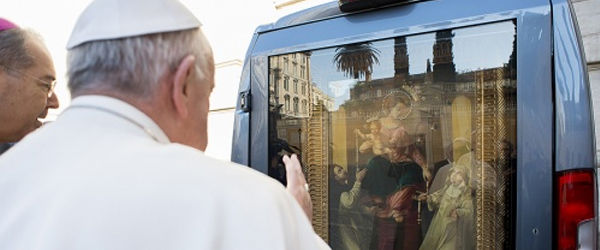Neither downed trees, nor damaged classrooms nor disrupted power suspended education for very long at three San Gabriel Region archdiocesan elementary schools affected by Southern California’s recent windstorm (Nov. 30-Dec. 1).
Assumption of the Blessed Virgin Mary School in Pasadena and Holy Name of Mary School in San Dimas resumed classes the following Monday, Dec. 5, as contractors rushed to replace a wind-damaged roof and a tree-damaged classroom, respectively.
Though St. Luke School in Temple City still was coping with a power outage Dec. 5 --- among the more than 400,000 Southern California Edison customers similarly affected by the windstorm --- students returned to chilly classrooms illuminated only with natural light streaming in through the windows until the school’s electricity was completely restored late Tuesday afternoon.
“They were real troopers,” said Erin Barisano, principal at St. Luke School. “They bundled up. It was a real adventure. The students will never forget this.”
Barisano put her new-this-year SchoolReach communication system to good use Dec. 1, alerting families that the school would be closed the rest of the week as city crews worked to clear the storm’s wreckage estimated to be more than $10 million in Temple City.
Overall, the windstorm caused at least $40 million in damage, with Pasadena sustaining damages of nearly $20 million from more than 1,200 downed trees that knocked out power lines and fell on cars and buildings, according to a Dec. 9 article in the L.A. Times.
Northridge resident Christine Hunter, principal of Assumption School, stayed at home Dec. 1 following the advice of the parish pastor, Father Gerard O’Brien, who informed her about several downed trees on the campus and local hazardous driving conditions.
Anxious about how the school buildings survived, she called her secretary who had arrived early to campus Thursday morning, after driving on debris-strewn streets, to send out a phone blast to parents telling them not to bring their children to school.
“The sky is really blue today,” said the secretary cryptically to Hunter, who hastily responded, “Tell me what it’s like inside the office.”
“I am in the office,” noted the secretary, looking up through holes made by ceiling tiles knocked out by 80-mile-per-hour winds which had blown off most of the roofing material, exposing wood slats. A school parent/roofer came promptly to clean it up.
“Everybody really worked together to clean it all up. It was pretty amazing,” said Hunter, who was at the school Friday and Saturday overseeing the clean-up.
As Pasadena tree removers were already inundated with requests, Hunter contacted a San Fernando Valley tree remover she knew to remove the huge pine tree which had fallen in front of the parish community center.
When she heard from the air conditioning/heating specialist on Sunday that their units were not leaking and safe to use, school families were contacted to return to school Monday, when roofers began to install a new roof completed by Dec. 9. Roofers then proceeded to tackle the damaged roofs on the church, Father O’Brien’s adjacent residence and the community center.
“The response from the archdiocese was amazing,” said Hunter, who praised the archdiocese’s property insurance carrier representative for handling the emergency while on her vacation. She told the insurance adjuster that it was important to get the campus repaired and landscaping in shape for its Jan. 2 Rose Parade “close-up,” since floats come right by the school.
“I’m pretty confident that, by the first of the year, we’ll look ok,” said Hunter.
Repairs on the roof over the seventh grade classroom at Holy Name of Mary School --- damaged by the toppling of a 40-year-old pine tree between the school’s two buildings --- were progressing ahead of original estimates. The fallen tree hit the classroom’s side entrance overhang and its branches punched holes in the ceiling, causing havoc with the lighting fixtures and ceiling tiles.
“The construction people told us it was the equivalent of an 8.0 earthquake,” said Debbie Marquez, seventh grade teacher. According to Lelana Moran, archdiocesan regional supervisor for elementary schools in the San Gabriel Region, the 51 schools she oversees are well-prepared for emergencies “because we so drill for earthquakes.”
“Disaster is something we prepare for all the time,” said Moran. “I thought the schools responded very well for what we should be doing.”
Several seventh grade parents came on Dec. 2 to move all the students’ desks to the faculty room, where it was expected that the children would have to be for many weeks. However, construction workers anticipate that the seventh-graders will be back in their classroom by Dec. 16. All of the building’s ceiling tiles will be replaced over the Christmas break.
Seventh grader, Ruby Neag, 12, said moving to the faculty room was an adjustment. “But, I think it’s a good experience because it challenges us to become better prepared, because we’re always interrupted since it’s the faculty room,” said Neag.
Classmate Nicholas Litwin said having a new classroom was different in a good way. “I kind of like it because it’s a new environment,” said Litwin.
“Children are very flexible as long as you coach it in positive ways,” said Marquez. “I told them we’re all working together and we’re all going to make the best of the situation. Religious education has had to double up on our classrooms so we have to use what we have for everyone.
“Nobody owns anything here, everything’s shared,” she pointed out to her students. “If you look at it that way, then it isn’t a hardship to share.”
{gallery width=100 height=100}gallery/2011/1216/storm/{/gallery}

